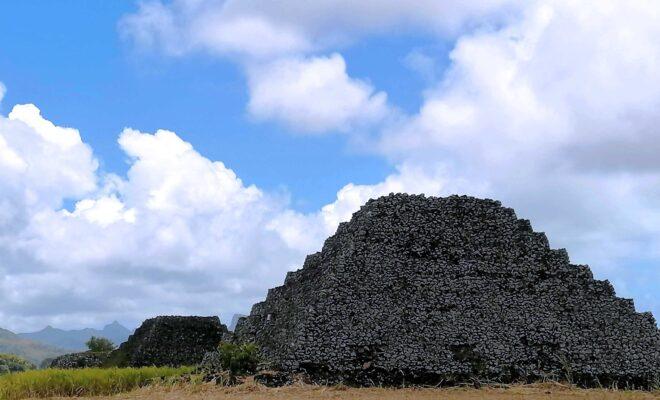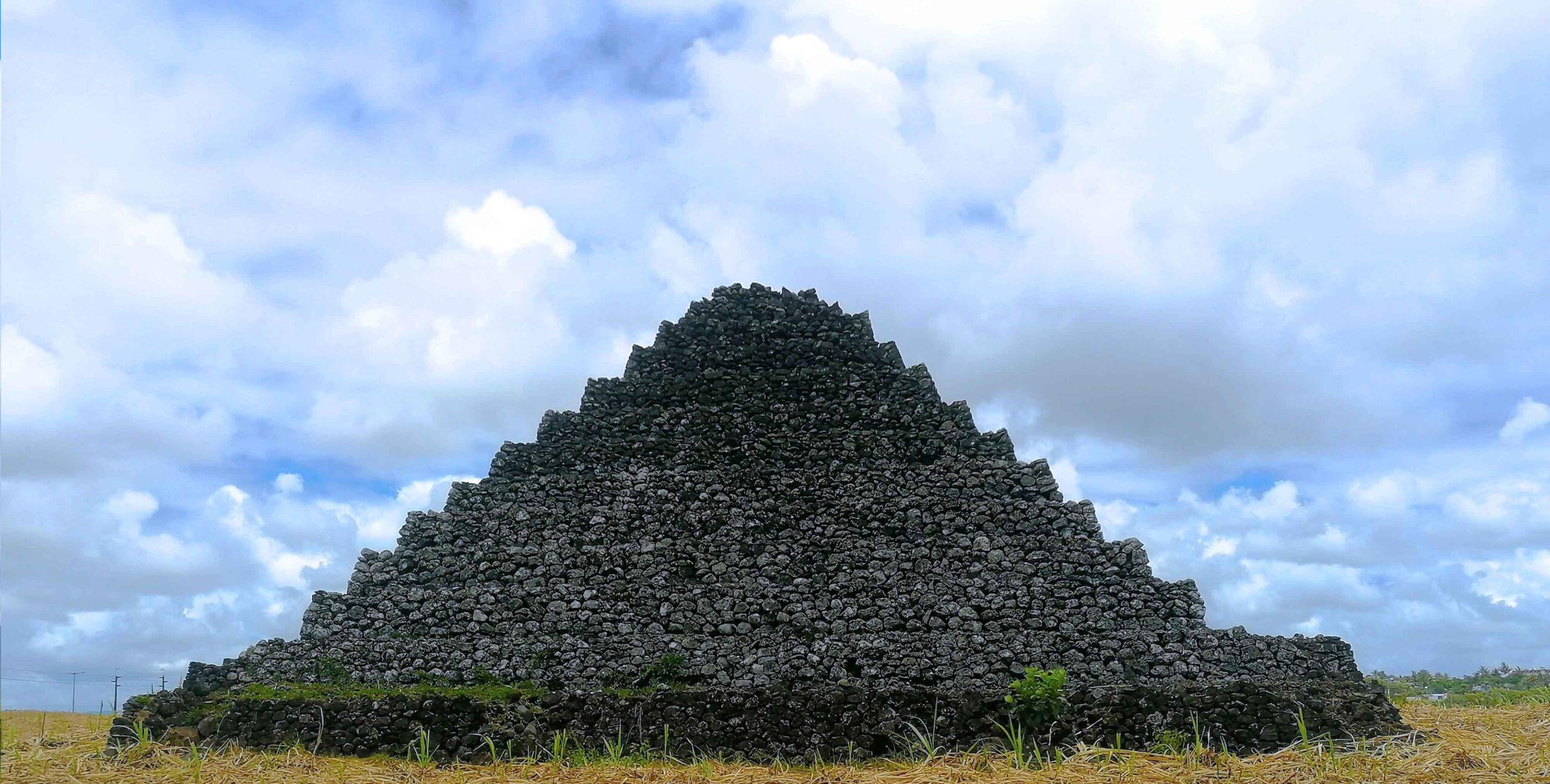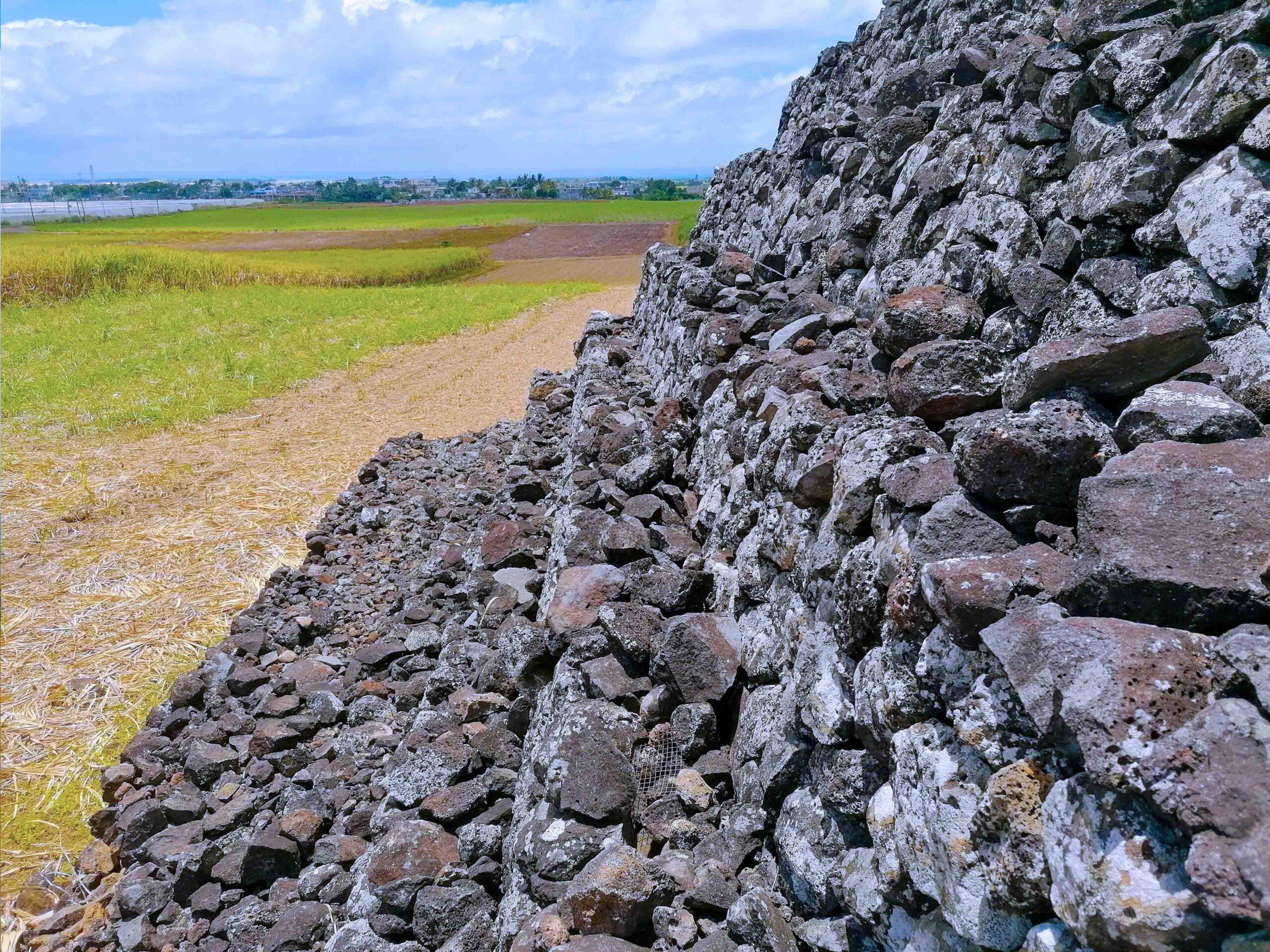Mauritius: How did the pyramids of Plaine Magnien get there?

From bored labourers to ancient gods, many theories abound about the pyramids’ origin, sparking a debate about colonial history.

One of the Pyramids of Plaine Magnien, on the island of Mauritius. Photo: Jacques Achilles.
It’s a sunny Saturday morning with a slight breeze, and an adventurous soul has clambered to the top of one of the famous pyramids of the Plaine Magnien in Mauritius. The ten-metre-high structure is one of a series of rock piles that rise majestically from the rolling green fields of sugar cane that surround the area.
For Jean Evaud, the tourist on the pyramid, this is the pinnacle of a dream trip come true. He had always wanted to do this; travel to Mauritius to immerse himself in this area. Enjoying the warm breeze that whistles as it hits the rocks, savouring the almost meditative sense of calm and taking in the scenery below the pyramids, he is content.
“I am here to get energy. I have read about this place, and I am convinced that this is true. I came here one week ago for holidays and also for the pyramids,” said Evaud.
The pyramids are made of black volcanic rocks, and appear to have been hewn and arranged in terraced steps – up to ten, in some of the structures – perfectly flat, perfectly symmetrical and with 90-degree angles. The platforms are rectangular, with the uppermost layers large enough to accommodate small groups of people. Interestingly, the structures are not supported by any mortar. The meticulous nature of the buildings has elicited a host of questions over the past several years.
From his vantage point, Evaud has a perfect view of the surroundings. To the south lies an endless stretch of the sea and the Sir Seewoosagur Ramgoolam International Airport; to the north is an expanse of sugar cane fields, with the motorway, which links the South to the North.
For the Mauritian government and researchers, the Plaine Magnien pyramids, which are now under the legal protection of the National Monument Board, may point to an ancient history that has for hundreds of years been buried under the colonial legacy that presupposed the country’s history started with the arrival of European explorers, missionaries and administrators.
To try to explain the pyramids’ existence, theories abound.

A side view of one of the Pyramids of Plaine Magnien, on the island of Mauritius. Photo: Jacques Achilles.
The most common is the belief that the pyramids are piles of rocks built by labourers working on the sugar cane fields – perhaps as watchtowers, perhaps just as a whim, or even for practical reasons – to use up all the unwanted volcanic rocks. Others are convinced they represent the work of a seafaring civilisation. Still others believe these to be the works of “gods”, channelling special energy from a revered mountain.
But the structures – now a major tourist attraction – have recently opened a discussion around the history of Mauritius. Like other ancient, complex and fascinating architectural wonders, the structures speak of flourishing civilisations in the pre-colonial period.
Mauritius, like its neighbours in the Indian Ocean Island – lying as they do on European explorers’ routes to East Asia – has had multiple colonial experiences that may have erased any evidence of ancient cultures. The first Europeans to arrive were the Portuguese, with the island first appearing on Portuguese maps in 1502. They were followed by the Dutch in 1598. Thereafter the island was colonised by the French in 1715 and the British in 1814, during which the expansion of the sugar plantations became the driving force for a dark and painful period of slavery.
Besides indentured labourers from India and China, slaves were shipped to Mauritius from the African hinterland, with the island home to a slave population of some 70,000 just prior to emancipation. Mauritius gained her independence in 1968.
Mauritian NGO, SOS Patrimoine, working for the preservation of the architectural patrimony of Mauritius, regards the pyramids simply as piles of rocks built up in the 1940s. However, no record exists to sustain this theory. Though piles of stones exist in some other sugarcane fields, none has been built in such an orderly and meticulous manner. Usually, the stones were simply piled up before being taken to stone crushing plants.

Pyramids of Plaine Magnien, on the island of Mauritius. Photo: Jacques Achilles.
According to renowned Mauritian yoga master and guru Yogi Tambi Chuckravanen, the pyramids are the remnants of an installation designed by an ancient civilisation to channel vital energy from the Lion Mountain, which is visible several kilometres away at the village of Grand Port. For the Yogi, it is the legacy of a former ancient civilisation on Kumari Kandam, which according to Dravidian mythology is a mythical continent that existed in the south of the Indian Ocean. That is the energy Evaud is keen to channel on this Saturday morning.
This theory is also similar to that of Lemuria, brought forward by scholars at the beginning of the last century in an attempt to explain the existence of lemurs in Madagascar and India and nowhere else; the idea that a large piece of land existed previously in this area but sank beneath the waves.
More recently, another theory has emerged.
According to Antoine Gigal, French writer and researcher known for her works on the pyramids of Egypt, the seven pyramids of Mauritius “are identical in construction to the ones found on the island of Tenerife, an island on the opposite side of the continent… Similar structures also exist on the Mediterranean island of Sicilia.”
She believes that the pyramids may have been built by travellers from Tenerife who, according to her, used the platform for observations of solar phenomena. This opens an avenue to a pre-colonial history that may even precede the early reports of Arab voyagers who, in around 900 AD, laying eyes on the island, called it Dina Arobi (Abandoned Island).
Abandoned by whom? one might ask.
A cane cutter who lives in a nearby village, said: “The ancients believed that the pyramids had always been there and told us different stories about their origins.”
Whatever its origins, Evaud, summoned from halfway around the world by the exotic nature of the island and who this Saturday morning is quietly revitalising his energy atop the pyramid, is just one of the thousands of visitors who, together, create an important source of revenue for the island of Mauritius.
Meanwhile, around the small village of Plaine Magnien, new roads are being built as part of major development projects. So far, no in-depth scientific research has been carried out on the pyramids. As legends and theories crop up and fade, the mystery of the pyramids continues to defy time, waiting on a more scientific and far more definitive analysis of their origin.
This story was originally published by the bird Story Agency.





I visited Mauritius three years ago and photographed and filmed the pyramids there.